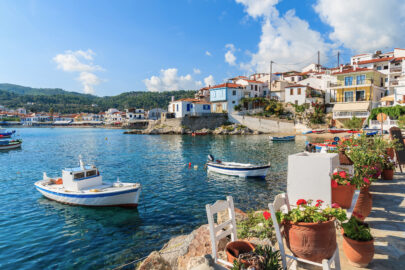Close to the Turkish coast, Samos is the southernmost of the Northern Aegean group of islands. It was, in fact, a part of the Asia Minor landmass until the Ice Age, and the towering volcanic mountains that soar dramatically are a part of the range that runs across western Turkey. Samos means high in Phoenician and the rocky outcrops are among the tallest in the Aegean with Mt. Kerkis seeming to rise from the sea and Mt. Ambelos shouldering the terraced vineyards that produce the famous Muscat of Samos wine.
Green and fertile with a craggy coastline and mountain balcony villages that look over the straits to Turkey, Samos is an island with a sleepy capital, Vathi, pretty Pythagoras, a handful of small resorts, off-the-beaten-track coves and a cool, forested interior.
During the Archaic era, while Athens was still young, Samos was already a political, economic a naval power in the Aegean. Under the patronage of the tyrant Polycrates, there was a thriving intellectual community that included Aesop, Aristarchus, Epicurus, and Pythagoras, and the vast Temple of Hera was one of the Seven Wonders of the Ancient World. However, decline set in during the Persian Wars, and in 439 BC Pericles defeated Samos and forced it to pay tribute to Athens.
Pirates ruled the island after it was abandoned by the Genoese until 1562 when the Ottomans repopulated Samos with Greek Orthodox settlers. Although the Samians fought bravely for independence in the war of the 1820s, it was handed back to the Turks in 1834 in what was known as the Hegemony and the island’s fortunes upturned as tobacco and shipping revived the economy. However, after the union with Greece in 1912, a flood of refugees in 1923 from Asia Minor and the hardships of a WW2 occupation impoverished Samos until tourism arrived in the 1970s.
Ask me anything
Explore related questions





